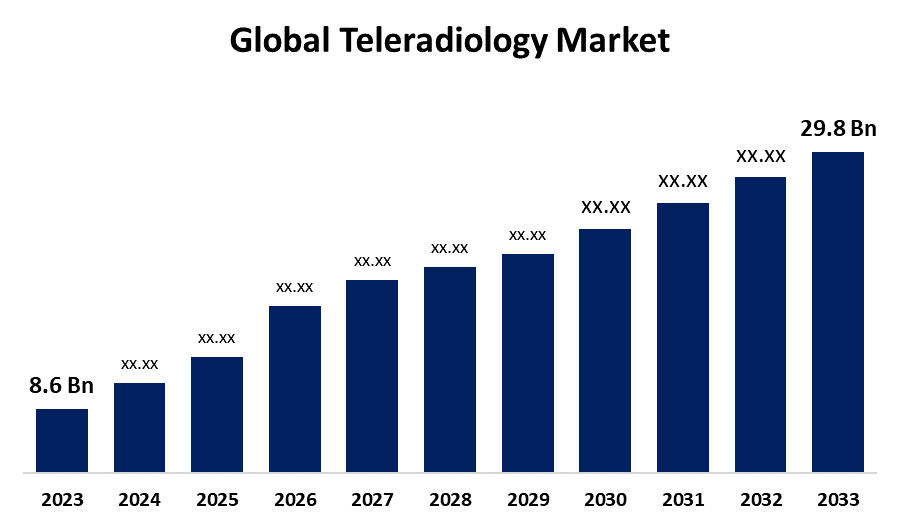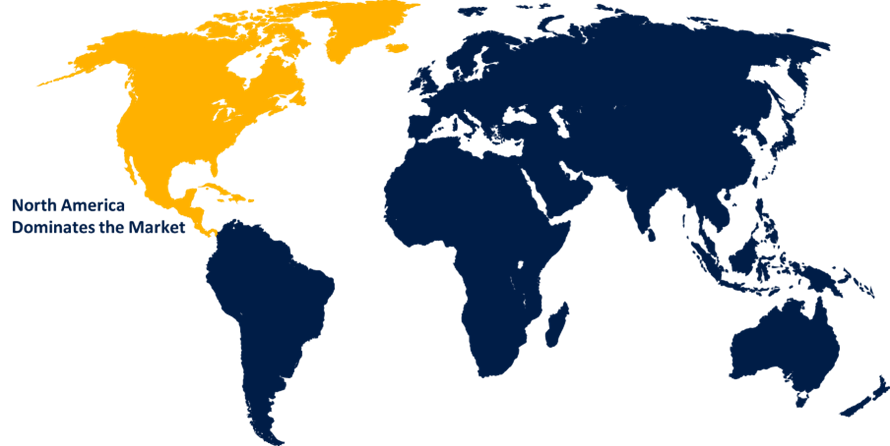Global Teleradiology Market Size, Share, and COVID-19 Impact Analysis, By Component (Software, Service, Hardware), By Imaging Technique (X-rays, Computed Tomography (CT), Ultrasound, Magnetic Resonance Imaging, Others), By End User (Hospitals & Clinics, Ambulatory Surgical Centers, Diagnostic Centers, Others), and By Region (North America, Europe, Asia-Pacific, Latin America, Middle East, and Africa), Analysis and Forecast 2023 – 2033.
Industry: HealthcareGlobal Teleradiology Market Insights Forecasts to 2033.
- The Global Teleradiology Market Size was Valued at USD 8.6 Billion in 2023.
- The Market Size is Growing at a CAGR of 13.23% from 2023 to 2033.
- The Worldwide Teleradiology Market Size is Expected to Reach USD 29.8 Billion by 2033.
- Europe is Expected to Grow the fastest during the forecast period.

Get more details on this report -
The Global Teleradiology Market Size is Anticipated to Exceed USD 29.8 Billion by 2033, Growing at a CAGR of 13.23% from 2023 to 2033.
Market Overview
Teleradiology is the transfer of radiological images from one site to another for interpretation and diagnosis by a radiologist. Examples include X-rays, CT scans, and MRIs. Images are safely delivered electronically via telecommunications technology, allowing professionals to interpret them remotely regardless of their geographical location. This method improves healthcare access, particularly in rural or disadvantaged areas, by delivering rapid diagnostic services. Teleradiology increases efficiency by allowing radiologists to interpret images remotely, resulting in shorter wait times and faster diagnosis and treatment decisions. Furthermore, it promotes collaboration among professionals and improves patient care by offering access to expertise regardless of physical location. The growing prevalence of chronic diseases, including cardiovascular disease, cancer, liver problems, spinal cord injury, and others, is a primary reason driving up demand for teleradiology software. With the growing demand for imaging diagnostics, a variety of radiology facilities and hospitals are implementing teleradiology systems.
Report Coverage
This research report categorizes the market for the global teleradiology market based on various segments and regions forecasts revenue growth and analyzes trends in each submarket. The report analyses the key growth drivers, opportunities, and challenges influencing the global teleradiology market. Recent market developments and competitive strategies such as expansion, product launch, and development, partnership, merger, and acquisition have been included to draw the competitive landscape in the market. The report strategically identifies and profiles the key market players and analyses their core competencies in each sub-segment of the global teleradiology market.
Global Teleradiology Market Report Coverage
| Report Coverage | Details |
|---|---|
| Base Year: | 2023 |
| Market Size in 2023: | USD 8.6 Billion |
| Forecast Period: | 2023-2033 |
| Forecast Period CAGR 2023-2033 : | 13.23% |
| 2033 Value Projection: | USD 29.8 Billion |
| Historical Data for: | 2019-2022 |
| No. of Pages: | 200 |
| Tables, Charts & Figures: | 110 |
| Segments covered: | By Component, By Imaging Technique, By End User, By Region |
| Companies covered:: | 4ways Healthcare Limited, Agfa-Gevaert Group, Carestream Health, FUJIFILM Corporation, General Electric Company, Koninklijke Philips N.V., ONRAD Inc., Oracle Corporation, RamSoft Inc., Siemens AG, Teleradiology Solutions, USARAD Holdings Inc., and Others Key Vendors |
| Pitfalls & Challenges: | Covid-19 Empact, Challenges, Growth, Analysis. |
Get more details on this report -
Driving Factors
The global teleradiology market is driven by various factors, including the growing need to make healthcare services more accessible, which necessitates increased accessibility for populations in distant areas, which teleradiology supports by allowing for remote interpretation of medical images. Teleradiology software's efficiency is crucial in emergency situations since it allows for faster diagnosis, more informed decisions, and more successful treatment regimens. Teleradiology's position in telemedicine and remote healthcare is consistent with the changing healthcare landscape, in which virtual consultations and services are becoming more prevalent. Advancements in connection and digital transformation in healthcare have considerably aided the expansion of teleradiology. In addition, the increase in federal funding is expected to fuel demand for teleradiology. Furthermore, the rise and expansion of the healthcare business, driven by both public and private actors, particularly in developing nations, will open up significant market growth potential. Moreover, imaging technology has advanced. Higher-resolution imaging, 3D imaging, and the use of artificial intelligence (AI) for image interpretation all improve the accuracy and efficiency of diagnostic procedures, boosting the market.
Restraining Factors
The expected expansion in the teleradiology business is hampered by a lack of broadband network availability and worries about data security. In areas with poor broadband connectivity, the efficiency of transferring medical images for remote interpretation may be hindered, preventing a flawless implementation.
Market Segmentation
The global teleradiology market share is classified into component, imaging technique, and end user.
- The service segment is expected to hold the largest share of the global teleradiology market during the forecast period.
Based on the component, the global teleradiology market is divided into software, service, hardware. Among these, the service segment is expected to hold the largest share of the global teleradiology market during the forecast period. Driven by the need for effective and timely healthcare solutions. The need for teleradiology services is increasing as healthcare recognizes the benefits of remote diagnosis. This sector's strong growth reflects an increased reliance on teleradiology for speedy and effective healthcare delivery, emphasizing its critical role in updating and optimizing diagnostic processes on a global scale.
- The computed tomography (CT) segment is expected to hold the largest share of the global teleradiology market during the forecast period.
Based on the imaging technique, the global teleradiology market is divided into X-rays, computed tomography (CT), ultrasound, magnetic resonance imaging, and others. Among these, the computed tomography (CT) segment is expected to hold the largest share of the global teleradiology market during the forecast period. CT excels at diagnosing a wide range of disorders, including trauma, cancer, and vascular problems. Its ability to generate high-resolution three-dimensional images has made it a vital technology in a variety of medical specializations. CT scans' flexibility and precision contribute to their continuous use in medical diagnostics, cementing its place as a cornerstone technology in the healthcare sector.
- The hospitals and clinics segment are expected to hold the largest share of the global teleradiology market during the forecast period.
Based on the end user, the global teleradiology market is divided into hospitals and clinics, ambulatory surgical centers, diagnostic centers, and others. Among these, the hospitals and clinics segment are expected to hold the largest share of the global teleradiology market during the forecast period. The growing demand for rapid and precise diagnostic imaging, combined with the efficiency and accessibility benefits given by the teleradiology business, positions hospitals and clinics as key contributors to the market's overall revenue.
Regional Segment Analysis of the Global Teleradiology Market
- North America (U.S., Canada, Mexico)
- Europe (Global, France, U.K., Italy, Spain, Rest of Europe)
- Asia-Pacific (China, Japan, India, Rest of APAC)
- South America (Brazil and the Rest of South America)
- The Middle East and Africa (UAE, South Africa, Rest of MEA)
North America is anticipated to hold the largest share of the global teleradiology market over the predicted timeframe.

Get more details on this report -
North America is anticipated to hold the largest share of the global teleradiology market over the predicted timeframe. The presence of modern healthcare infrastructure, payment coverage for telehealth, and supportive government efforts and reforms for digital health are only a few of the factors driving the rise of the teleradiology sector. Improvements also have an impact on the development of the teleradiology industry in mobile health technology, increasing public knowledge of the benefits of telehealth, and a greater emphasis on value-based healthcare and population health management.
Europe is expected to grow the fastest during the forecast period. There is a rising awareness regarding the benefits of remote radiological services. Countries such as the United Kingdom, Germany, and France have made significant investments in healthcare IT infrastructure, resulting in greater usage of teleradiology systems. Furthermore, the European market benefits from a significant emphasis on patient data protection and privacy, which increases demand for safe teleradiology services.
Competitive Analysis:
The report offers the appropriate analysis of the key organizations/companies involved within the global teleradiology market along with a comparative evaluation primarily based on their product offering, business overviews, geographic presence, enterprise strategies, segment market share, and SWOT analysis. The report also provides an elaborative analysis focusing on the current news and developments of the companies, which includes product development, innovations, joint ventures, partnerships, mergers & acquisitions, strategic alliances, and others. This allows for the evaluation of the overall competition within the market.
List of Key Companies
- 4ways Healthcare Limited
- Agfa-Gevaert Group
- Carestream Health
- FUJIFILM Corporation
- General Electric Company
- Koninklijke Philips N.V.
- ONRAD Inc.
- Oracle Corporation
- RamSoft Inc.
- Siemens AG
- Teleradiology Solutions
- USARAD Holdings Inc.
- Others
Key Target Audience
- Market Players
- Investors
- End-users
- Government Authorities
- Consulting and Research Firm
- Venture capitalists
- Value-Added Resellers (VARs)
Recent Development
- In May 2023, IMEXHS and deepc announced the official launch of their new solution offering, IMEX AI. Powered by deepc. The collaboration between IMEXHS and deepc combines their strengths, creating a one-stop shop for medical imaging needs.
- In August 2021, Nano X Imaging Ltd., an innovative medical imaging company, has announced a binding letter of intent for the acquisition of USARAD and its subsidiary company, Medical Diagnostics Web (MDW). USARAD maintains a global network of 300 radiologists.
Market Segment
This study forecasts revenue at regional, and country levels from 2020 to 2033. Spherical Insights has segmented the global teleradiology market based on the below-mentioned segments:
Global Teleradiology Market, By Component
- Software
- Service
- Hardware
Global Teleradiology Market, By Imaging Technique
- X-rays
- Computed Tomography (CT)
- Ultrasound
- Magnetic Resonance Imaging
- Others
Global Teleradiology Market, By End User
- Hospitals and Clinics
- Ambulatory Surgical Centers
- Diagnostic Centers
- Others
Global Teleradiology Market, By Region
- North America
- US
- Canada
- Mexico
- Europe
- Germany
- Uk
- France
- Italy
- Spain
- Russia
- Rest of Europe
- Asia Pacific
- China
- Japan
- India
- South Korea
- Australia
- Rest of Asia Pacific
- South America
- Brazil
- Argentina
- Rest of South America
- Middle East & Africa
- UAE
- Saudi Arabia
- Qatar
- South Africa
- Rest of the Middle East & Africa
Frequently Asked Questions (FAQ)
-
1. What is the teleradiology?Teleradiology is a subfield of telemedicine in which telecommunications systems are utilized to send radiological pictures from one location to another.
-
2. What are the driving factors of global teleradiology market?The technological advancements and the increased prevalence of the chronic disease are driving the teleradiology market.
-
3. What is the CAGR of the global teleradiology market?13.23% is the CAGR of the global teleradiology market.
Need help to buy this report?